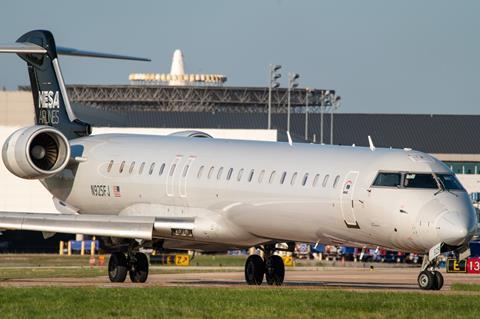Following more than a month of delays, Mesa Air Group on 26 January filed its fiscal fourth-quarter earnings report – potentially helping it avoid being de-listed from the US Nasdaq stock exchange.
The parent of US regional carrier Mesa Airlines received a 4 January notice from US authorities that it had failed to comply with listing rules because it hadn’t filed an end-of-year report for the period ending 30 September.
Now, the company reports losing $120 million during the fiscal year ending on that date, compared with a $183 million loss in the equivalent prior period. It generated $498 million in revenue, down from $531 million in fiscal 2022.

Mesa had originally scheduled its fourth-quarter earnings call for 14 December. On that date, it submitted a notification of late filing with the US Securities and Exchange Commission, which automatically granted the company a 15-day extension.
At the time, the company said it expected to file its results “no later” than the 29 December deadline, and that it would soon announce a new date for its conference call. But that date passed without a fiscal fourth quarter report from Mesa.
It is unclear whether the company’s 26 January filing effectively averts Mesa’s de-listing from the stock exchange. Mesa did not immeditely respond to a query about its status of compliance with the Nasdaq’s rules.
Mesa recently revealed that the delay was related to a “$30 million factual balance sheet mis-statement”, according to the company’s financial filings.
Chief executive Jonathan Ornstein told FlightGlobal that the discrepancy arose due to poor monitoring of a loan that had been transferred from a bank to United Airlines during its transition to flying its Bombardier CRJ900s on behalf of the major US carrier.
Mesa previously operated those aircraft on behalf of American Airlines. That relationship was severed in December 2022 in favour of a five-year capacity purchase agreement with United.
The Phoenix-based carrier has since struggled both financially and operationally. Amid a pilot shortage that has grounded many of its jets, Mesa has not flown enough block hours to cover costs.
”The severity of the pilot shortage, elevated pilot attrition, the transition of our operations with American to United, and increasing costs associated with pilot wages adversely impacted our financial results, cash flows and financial position,” the carrier says.
During its fiscal fourth quarter, Mesa flew 21% fewer block hours and 17% fewer passengers than in the equivalent period of 2022.
However, Mesa recently re-worked its agreement with United to boost its block-hour rate through 31 December, which it estimates will generate $63.5 million of additional revenue. It has also been selling spare CRJ900s and engines in an effort to firm its financial footing.
”Block-hour production is heavily dependent on pilot attrition and hiring, and we remain focused on driving pilot throughput, executing captain upgrades and holding attrition at stabilised levels,” Ornstein says.
The company lost $28.3 million during the fourth-quarter fiscal period, compared with a $116 million loss last year.
Meanwhile, it generated revenue of $114 million, compared with $126 million during the three months ending 30 September 2022.
As of 30 September, the airline operated about 80 regional jets – a mix of CRJ900s and Embraer 175s – and four Boeing 737s on behalf of DHL Express.


























